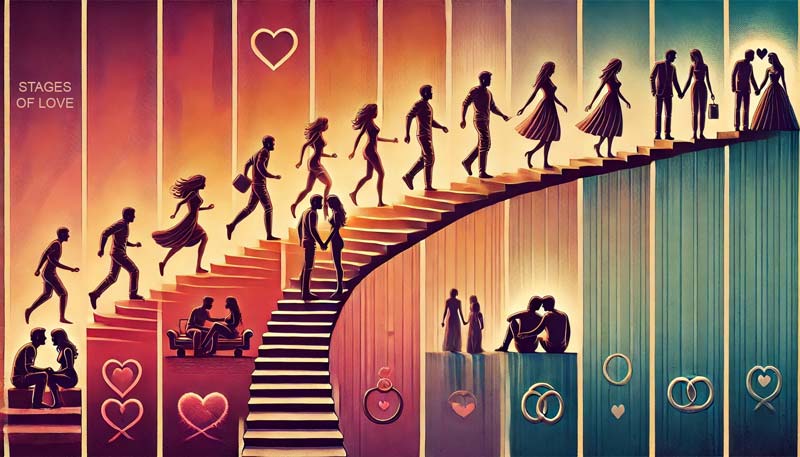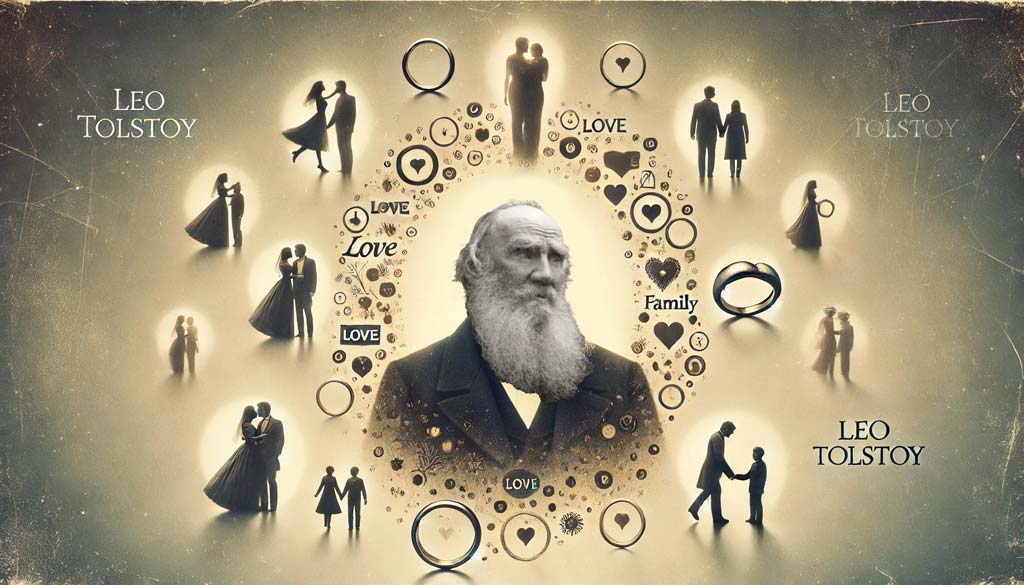The 13 stages of love, as depicted in Leo Tolstoy’s “Family Happiness”, offer a thoughtful glimpse into the evolution of relationships. This revelation came to me unexpectedly during a visit to Oxford with my BFF Bryan.
As we strolled past an Oxfam charity shop, Bryan decided to pop in, searching for business books. I followed, immediately drawn to a locked glass cabinet housing a collection of old, leather-bound books. The sight stirred my passion for first editions and vintage publications.
Among these treasures, I discovered Tolstoy’s “The Kreutzer Sonata and Other Stories,” published by Oxford University Press in 1957. The moment I began reading “Family Happiness,” I was utterly captivated. Tolstoy’s ability to make the story come alive was unlike anything I’d experienced since reading “The Celestine Prophecy” and “To Kill a Mockingbird.”
As someone who’s faced infidelity, the story struck a deep chord. It painfully and honestly highlighted the dynamic nature of love and relationships. I re-read the novella multiple times, each passing revealing new layers of insight.
Tolstoy’s vivid descriptions transported me into the story. I could feel the scenes unfolding around me, smell the Russian countryside, and sense the characters’ emotions as if they were my own. This immersive experience allowed me to see the progression of love with newfound clarity.
In the following sections, I’ll share my thoughts on the 13 stages of love I’ve identified in Tolstoy’s tale. These aren’t the daydreams of a relationship expert but rather the reflections of someone who’s found unexpected wisdom in a century-old story. I hope these insights resonate with others dealing the complexities of love and relationships.
Discovering Tolstoy’s “Family Happiness”
My encounter with “Family Happiness” was more than just finding a book; it uncovered a mirror of my experiences with love and emotional resonance. As I held the 1957 Oxford University Press edition, its worn leather cover spoke of the timeless nature of Tolstoy’s insights into the stages of love.
The story centres on Mashechka (Masha), a 17-year-old girl, and her relationship with Sergey Mikhaylych, a 36-year-old family friend. Tolstoy’s narrative told through Masha’s eyes, paints a vivid picture of love’s evolution. From the first sparks of attraction to the settled comfort of mature companionship, the stages of love unfold with striking realism.
Masha’s initial infatuation with Sergey blossoms into a deep connection, nurtured through long conversations and shared moments. Their early marriage is a whirlwind of joy, an “exclusive little world of frantic happiness” that feels eternal. However, the intensity fades as routines set in and a child arrives. Masha finds herself adrift, seeking excitement in St. Petersburg’s social whirl, while Sergey grows distant.
The stages of love take a tumultuous turn as Masha flirts with other men, causing conflict with Sergey. Their relationship teeters on the brink, raw emotions spilling out in heated confrontations. Yet, through this turmoil, they find a path to understanding and acceptance.
As I read and re-read the novella, five broad stages of love emerged:
- Initial attraction and falling in love: Masha feels an immediate connection and strong attraction when she first meets her future husband, Sergey. Their love grows over time, especially during long conversations and shared activities.
- Early marital bliss: After getting married, the couple experiences a period of intense happiness, feeling utterly devoted to one another and sharing everything. They are in their own “exclusive little world of frantic happiness.”
- Disillusionment and growing apart: As they settle into everyday life and have a child, the excitement and intensity fade. They drift apart, Masha feels depressed, and there is tension underlying their politeness.
- Affairs and turmoil: Masha indulges in the lively social scene in St. Petersburg, including some flirtations with other men. This causes conflict with Sergey. There is an emotional scene where hurts are expressed.
- Acceptance and mature love: As time passes, the couple reaches a calm understanding and acceptance of each other and their situation. Their love has changed into steady, realistic companionship. Masha comes to value their shared family life.
While drawn from Tolstoy’s 19th-century Russia, these stages of love struck me as remarkably relevant to modern relationships. They formed the foundation for my more profound look into the nuanced progression of love, ultimately identifying 13 distinct stages.
Tolstoy’s creative ability to bring a story to life allowed me to see my experiences in a new light. His exploration of self-development, the meaning of life in the face of death, and the role of pain, suffering, and compassion in achieving happiness and realisation resonated deeply with my journey through love.

The 13 Stages of Love: From Passion to Partnership
As I dug deeper into Tolstoy’s story, I geeked out excitedly. Years of picking apart spoken and written words came in handy as I saw patterns emerge. The five broad stages I first spotted barely scratched the surface of the rollercoaster ride these characters were on.
I couldn’t help but draw parallels to real-life relationships I’d seen and experienced. After countless re-reads and scribbled notes, I sketched a more detailed map of love’s journey. This led me to identify distinct stages of love, each marking a significant shift in how couples relate.
Here are the 13 stages of love I identified, with more detailed explanations of how they play out in real-life relationships:
- Initial chemistry and attraction: That intoxicating rush when two people first meet and feel sparks fly. Infatuation triggers a cocktail of feel-good chemicals, creating an intense desire to be near each other. The future seems full of endless possibilities.
- Growing affection and “falling in love”: As intimacy builds through shared experiences, backgrounds, and dreams, the attachment deepens. Feelings intensify, and priorities shift to focus on the beloved. It feels like this must be what true love is all about.
- Passion and optimism during courtship/engagement: Once committed to building a future together, optimism soars. The romantic partnership is the missing piece that completes each other’s lives. Passion runs high, extending beyond just the physical.
- Wedding and honeymoon bliss: This public commitment is a hard-won prize. The ceremonies blend past and present, celebrating a new, shared identity. The couple’s focus narrows to just the two of them.
- Adjusting to married life and new roles: The newlywed glow fades as couples wrestle with domestic realities. Irritations crop up, and individual identities clash with new spousal roles. It’s a far cry from the romantic comedy fantasy.
- Emotionally bonding through building family: The arrival of children, who are part-me and part-you, shifts priorities, often unevenly. Attachment bonds reform as the couple focuses on caring for their new, helpless family members.
- Restlessness and boredom as routine sets in. Dissatisfaction creeps in despite living the marriage fantasy. Passion wanes with repetition. Emotional needs once met now get overlooked as days blur together.
- Seeking independence or outside excitement: Cravings for intensity, variety, and freedom build up. Flattering attention from others becomes more challenging to resist, and the “grass is greener” mentality takes hold.
- Major relationship struggles and wake-up calls: Cracks can no longer be ignored as the relationship reaches a crisis point. Communication breaks down entirely. The very survival of the partnership hangs in the balance.
- Emotional conversations leading to understanding: The emotional logjam finally breaks. Beneath the blame and dysfunction, sincere communication emerges. Couples rediscover each other’s inner worlds and how they arrived at this point.
- Accepting the relationship has fundamentally changed: The old way of loving each other is recognised as gone forever. Mourning gives way to accepting each other and the partnership for what they’ve become.
- Valuing commitment and companionship: With naivety shed and masks lowered, the choice deepens – to continue the journey together as intimate companions or to part ways entirely.
- Rebuilding love on a mature, caring foundation: All these stages have transformed individuals and the space between them. A renewed relationship emerges where love still breathes, now built sturdier on authenticity and mutual understanding.
These stages of love offer a framework for understanding how relationships evolve over time.
Applying Tolstoy’s Insights to Modern Relationships
Reflected on Tolstoy’s portrayal of Masha and Sergey’s relationship, I couldn’t help but see parallels with modern love stories, including my own. The stages of love I identified are not relics of 19th-century Russia; they’re alive and well in our relationships today.
Many of us enter relationships with the fairytale notion that the initial rush of falling in love will last forever. We expect to “live happily ever after,” indefinitely preserving that intoxicating feeling of new love. But Tolstoy’s insights and real-life tell us a different story.
The truth is love evolves. It transforms. It asks more of us than simply recreating those first thrilling emotions. As routines settle in, children arrive, and careers develop, our needs and expectations shift. The steady, caring love that Masha and Sergey ultimately find isn’t a consolation prize—it’s a hard-won achievement built on understanding and maturity.
Break-ups and divorce (well, in my case, done behind my back by a nasty, evil human), unable to weather the storms of changing love. They expected love to remain fixed at that initial stage of passion and excitement. When it inevitably changed, they felt cheated and disappointed. But what if we approached relationships with a more nuanced understanding of love’s journey?
Recognising these stages of love can be a game-changer. It allows us to weather the storms of the ups and downs with more grace and understanding. When the honeymoon phase fades and routine sets in, we can recognise it as a natural progression rather than a sign of failure. When conflicts arise, we can see them as opportunities for growth and deeper understanding.
Taking this long view of love’s complexity doesn’t diminish its value—it enhances it. It helps us temper our initial high expectations with a realistic appreciation for the depth and richness that come with time and shared experiences.
Tolstoy’s story shows us that it’s possible to revive and renew love, even after significant struggles. But it requires work. It demands self-reflection, honest communication, and a willingness to grow together.
In our modern world of instant gratification and quick fixes, embracing this journey of love can seem daunting. But the rewards—a deep, mature love built on genuine understanding and acceptance—are immeasurable.
Being mindful of these stages of love, we give ourselves and our partners the grace to evolve. We create space for love to transform to meet our changing needs at different life stages. In doing so, we open ourselves to a richer, deeper, and more fulfilling love than we might have imagined.

The Cyclical Nature of Love: Embracing Change and Looking Forward
Tolstoy’s “Family Happiness” and our exploration of the 13 stages of love reveal a reflective truth: love is not a straight line but a cycle of growth, challenge, and renewal. As we’ve seen, relationships evolve, often revisiting earlier stages in new forms.
Understanding this cyclical nature can transform how we approach our partnerships. Instead of fearing change, we can embrace it as an opportunity for a deeper connection. Each cycle brings the chance to rediscover our partners and ourselves.
Looking forward, the key is to remain adaptable and open-hearted. By recognising love’s ongoing journey, we can approach each stage with curiosity and compassion. This mindset allows us to build resilient, dynamic, and fulfilling relationships.
Ultimately, Tolstoy’s insights remind us that love is not a destination but a lifelong journey of mutual growth and understanding.
Man, I sound like an expert now, don’t I? But trust me, I’m far from it. I’m a bloke who stumbled upon a story that spoke to me and found meaning in its pages. Maybe that’s the natural beauty of great literature – it helps us make sense of our own experiences, even when we’re not looking for answers.
Thank you to Tolstoy, Masha and Sergey at 46, I now see the Stages of Love!
Sources
- The Kreutzer Sonata and Other Stories. 1957. Oxford University Press, London. Translated by J.D. Duff & Aylmer Maude.
Credits
- Original portrait of Leo Tolstoy in featured image sourced from Wikimedia Commons, Author: Vladimir Chertkov (Чертков).


